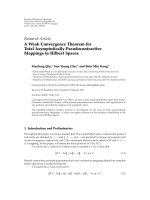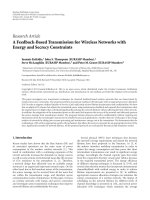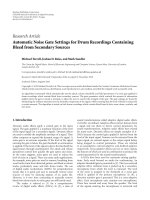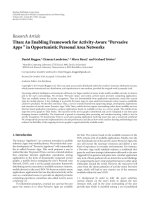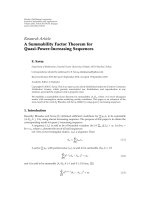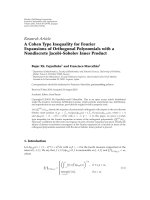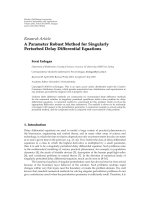Báo cáo hóa học: " Research Article A Weak Convergence Theorem for Total Asymptotically Pseudocontractive Mappings in Hilbert Spaces" potx
Bạn đang xem bản rút gọn của tài liệu. Xem và tải ngay bản đầy đủ của tài liệu tại đây (492.63 KB, 11 trang )
Hindawi Publishing Corporation
Fixed Point Theory and Applications
Volume 2011, Article ID 859795, 11 pages
doi:10.1155/2011/859795
Research Article
A Weak Convergence Theorem for
Total Asymptotically Pseudocontractive
Mappings in Hilbert Spaces
Xiaolong Qin,
1
Sun Young Cho,
2
and Shin Min Kang
3
1
School of Mathematics and Information Sciences, North China University of Water Resources and
Electric Power, Zhengzhou 450011, China
2
Department of Mathematics, Gyeongsang National University, Jinju 660-701, Republic of Korea
3
Department of Mathematics and RINS, Gyeongsang National University, Jinju 660-701, Republic of Korea
Correspondence should be addressed to Shin Min Kang,
Received 13 December 2010; Accepted 1 February 2011
Academic Editor: Yeol J. Cho
Copyright q 2011 Xiaolong Qin et al. This is an open access article distributed under the Creative
Commons Attribution License, which permits unrestricted use, distribution, and reproduction in
any medium, provided the original work is properly cited.
The modified Ishikawa iterative process is investigated for the class of total asymptotically
pseudocontractive mappings. A weak convergence theorem of fixed points is established in the
framework of Hilbert spaces.
1. Introduction and Preliminaries
Throughout this paper, we always assume that H is a real Hilbert space, whose inner product
and norm are denoted by ·, · and ·. → and are denoted by strong convergence and
weak convergence, respectively. Let C be a nonempty closed convex subset of H and T : C →
C a mapping. In this paper, we denote the fixed point set of T by FT.
T is said to be a contraction if there exists a constant α ∈ 0, 1 such that
Tx − Ty
≤ α
x − y
, ∀x, y ∈ C. 1.1
Banach contraction principle guarantees that every contractive mapping defined on complete
metric spaces has a unique fixed point.
T is said to be a weak contraction if
Tx − Ty
≤
x − y
− ψ
x − y
,
∀x, y ∈ C, 1.2
2 Fixed Point Theory and Applications
where ψ : 0, ∞ → 0, ∞ is a continuous and nondecreasing function such that ψ is positive
on 0, ∞, ψ00, and lim
t →∞
ψt∞. We remark that the class of weak contractions was
introduced by Alber and Guerre-Delabriere 1. In 2001, Rhoades 2 showed that every weak
contraction defined on complete metric spaces has a unique fixed point.
T is said to be nonexpansive if
Tx − Ty
≤
x − y
, ∀x, y ∈ C. 1.3
T is said to be asymptotically nonexpansive if there exists a sequence {k
n
}⊂1, ∞ with
k
n
→ 1asn →∞such that
T
n
x − T
n
y
≤ k
n
x − y
, ∀n ≥ 1,x,y∈ C. 1.4
The class of asymptotically nonexpansive mappings was introduced by Goebel and Kirk
3 as a generalization of the class of nonexpansive mappings. They proved that if C is a
nonempty closed convex bounded subset of a real uniformly convex Banach space and T is
an asymptotically nonexpansive mapping on C, then T has a fixed point.
T is said to be asymptotically nonexpansive in the intermediate sense if it is continuous and
the following inequality holds:
lim sup
n →∞
sup
x,y∈C
T
n
x − T
n
y
−
x − y
≤ 0.
1.5
Observe that if we define
ξ
n
max
0, sup
x,y∈C
T
n
x − T
n
y
−
x − y
,
1.6
then ξ
n
→ 0asn →∞. It f ollows that 1.5 is reduced to
T
n
x − T
n
y
≤
x − y
ξ
n
, ∀n ≥ 1,x,y∈ C. 1.7
The class of mappings which are asymptotically nonexpansive in the intermediate sense
was introduced by Bruck et al. 4see also 5. It is known 6 that if C is a nonempty
closed convex bounded subset of a uniformly convex Banach space E and T is asymptotically
nonexpansive in the intermediate sense, then T has a fixed point. It is worth mentioning that
the class of mappings which are asymptotically nonexpansive in the intermediate sense may
not be Lipschitz continuous; see 5, 7.
T is said to be total asymptotically nonexpansive if
T
n
x − T
n
y
≤
x − y
μ
n
φ
x − y
ξ
n
, ∀n ≥ 1,x,y∈ C, 1.8
where φ : 0, ∞ → 0, ∞ is a continuous and strictly increasing function with φ00and
{μ
n
} and {ξ
n
} are nonnegative real sequences such that μ
n
→ 0andξ
n
→ 0asn →∞.
The class of mapping was introduced by Alber et al. 8. From the definition, we see that
Fixed Point Theory and Applications 3
the class of total asymptotically nonexpansive mappings includes the class of asymptotically
nonexpansive mappings and the class of asymptotically nonexpansive mappings in the
intermediate sense as special cases; see 9, 10 for more details.
T is said to be strictly pseudocontractive if there exists a constant κ ∈ 0, 1 such that
Tx − Ty
≤
x − y
2
κ
I −Tx − I − Ty
2
, ∀x, y ∈ C.
1.9
The class of strict pseudocontractions was introduced by Browder and Petryshyn 11 in a
real Hilbert space. In 2007, Marino and Xu 12 obtained a weak convergence theorem for the
class of strictly pseudocontractive mappings; see 12 for more details.
T is said to be an asymptotically strict pseudocontraction if there exist a constant κ ∈ 0, 1
and a sequence {k
n
}⊂1, ∞ with k
n
→ 1asn →∞such that
T
n
x − T
n
y
2
≤ k
n
x − y
2
κ
I −T
n
x −
I −T
n
y
2
, ∀n ≥ 1,x,y∈ C.
1.10
The class of asymptotically strict pseudocontractions was introduced by Qihou 13
in 1996. Kim and Xu 14 proved that the class of asymptotically strict pseudocontractions
is demiclosed at the origin and also obtained a weak convergence theorem for the class of
mappings; see 14 for more details.
T is said to be an asymptotically strict pseudocontraction in the intermediate sense if there
exist a constant κ ∈ 0, 1 and a sequence {k
n
}⊂1, ∞ with k
n
→ 1asn →∞such that
lim sup
n →∞
sup
x,y∈C
T
n
x − T
n
y
2
− k
n
x − y
2
− κ
I −T
n
x −
I −T
n
y
2
≤ 0.
1.11
Put
ξ
n
max
0, sup
x,y∈C
T
n
x − T
n
y
2
− k
n
x − y
2
− κ
I −T
n
x −
I −T
n
y
2
.
1.12
It follows that ξ
n
→ 0asn →∞. Then, 1.11 is reduced to the following:
T
n
x − T
n
y
2
≤ k
n
x − y
2
κ
I −T
n
x −
I −T
n
y
2
ξ
n
, ∀n ≥ 1,x,y∈ C.
1.13
The class of mappings was introduced by Sahu et al. 15. They proved that the class of
asymptotically strict pseudocontractions in the intermediate sense is demiclosed at the origin
and also obtained a weak convergence theorem for the class of mappings; see 15 for more
details.
T is said to be asymptotically pseudocontractive if there exists a sequence {k
n
}⊂1, ∞
with k
n
→ 1asn →∞such that
T
n
x − T
n
y, x − y
≤ k
n
x − y
2
, ∀n ≥ 1,x,y∈ C.
1.14
4 Fixed Point Theory and Applications
It is not hard to see that 1.14 is equivalent to
T
n
x − T
n
y
2
≤
2k
n
− 1
x − y
2
x − y −
T
n
x − T
n
y
2
, ∀n ≥ 1,x,y∈ C.
1.15
The class of asymptotically pseudocontractive mapping was introduced by Schu 16see
also 17.In18, Rhoades gave an example to showed that the class of asymptotically
pseudocontractive mappings contains properly the class of asymptotically nonexpansive
mappings; see 18 for more details. Zhou 19 showed that every uniformly Lipschitz and
asymptotically pseudocontractive mapping which is also uniformly asymptotically regular
has a fixed point.
T is said to be an asymptotically pseudocontractive mapping in the intermediate sense if
there exists a sequence {k
n
}⊂1, ∞ with k
n
→ 1asn →∞such
lim sup
n →∞
sup
x,y∈C
T
n
x − T
n
y, x − y
− k
n
x − y
2
≤ 0.
1.16
Put
ξ
n
max
0, sup
x,y∈C
T
n
x − T
n
y, x − y
− k
n
x − y
2
.
1.17
It follows that ξ
n
→ 0asn →∞. Then, 1.16 is reduced to the following:
T
n
x − T
n
y, x − y
≤ k
n
x − y
2
ξ
n
, ∀n ≥ 1,x,y∈ C.
1.18
It is easy to see that 1.18 is equivalent to
T
n
x − T
n
y
2
≤
2k
n
− 1
x − y
2
x − y −
T
n
x − T
n
y
2
2ξ
n
, ∀n ≥ 1,x,y∈ C.
1.19
The class of asymptotically pseudocontractive mappings in the intermediate sense was
introduced by Qin et al. 20. Weak convergence theorems of fixed points were established
based on iterative methods; see 20 for more details.
In this paper, we introduce the following mapping.
Definition 1.1. Recall that T : C → C is said to be total asymptotically pseudocontractive if there
exist sequences {μ
n
}⊂0, ∞ and {ξ
n
}⊂0, ∞ with μ
n
→ 0andξ
n
→ 0asn →∞such that
T
n
x − T
n
y, x − y
≤
x − y
2
μ
n
φ
x − y
ξ
n
, ∀n ≥ 1,x,y∈ C,
1.20
where φ : 0, ∞ → 0, ∞ is a continuous and strictly increasing function with φ00.
Fixed Point Theory and Applications 5
It is easy to see that 1.20 is equivalent to the following:
T
n
x − T
n
y
2
≤
x − y
2
2μ
n
φ
x − y
x − y −
T
n
x − T
n
y
2
2ξ
n
,
∀n ≥ 1,x,y∈ C.
1.21
Remark 1.2. If φλλ
2
, then 1.20 is reduced to
T
n
x − T
n
y, x − y
≤
1 μ
n
x − y
2
ξ
n
, ∀n ≥ 1,x,y∈ C.
1.22
Remark 1.3. Put
ξ
n
max
0, sup
x,y∈C
T
n
x − T
n
y, x − y
−
1 μ
n
x − y
2
.
1.23
If φλλ
2
, then the class of total asymptotically pseudocontractive mappings is reduced to
the class of asymptotically pseudocontractive mappings in the intermediate sense.
Recall that the modified Ishikawa iterative process which was introduced by Schu 16
generates a sequence {x
n
} in the following manner:
x
1
∈ C,
y
n
β
n
T
n
x
n
1 − β
n
x
n
,
x
n1
α
n
T
n
y
n
1 − α
n
x
n
, ∀n ≥ 1,
1.24
where T : C → C is a mapping, x
1
is an initial value, and {α
n
} and {β
n
} are real sequences in
0, 1.
If β
n
0 for each n ≥ 1, then the modified Ishikawa iterative process 1.24 is reduced
to the following modified Mann iterative process:
x
1
∈ C, x
n1
α
n
T
n
x
n
1 − α
n
x
n
, ∀n ≥ 1. 1.25
The purpose of this paper is to consider total asymptotically pseudocontractive
mappings based on the modified Ishikawa iterative process. Weak convergence theorems are
established in real Hilbert spaces.
In order to prove our main results, we also need the following lemmas.
Lemma 1.4. In a real Hilbert space, the following inequality holds:
ax
1 − a
y
2
a
x
2
1 − a
y
2
− a
1 − a
x − y
2
, ∀a ∈
0, 1
,x,y∈ C.
1.26
6 Fixed Point Theory and Applications
Lemma 1.5 see 21. Let {r
n
}, {s
n
}, and {t
n
} be three nonnegative sequences satisfying the
following condition:
r
n1
≤
1 s
n
r
n
t
n
, ∀n ≥ n
0
, 1.27
where n
0
is some nonnegative integer. If
∞
n1
s
n
< ∞ and
∞
n1
t
n
< ∞,thenlim
n →∞
r
n
exists.
2. Main Results
Now, we are ready to give our main results.
Theorem 2.1. Let C be a nonempty closed convex subset of a real Hilbert space H and T : C → C
a uniformly L-Lipschitz and total asymptotically pseudocontractive mapping as defined in 1.20.
Assume that FT is nonempty and there exist positive constants M and M
∗
such that φλ ≤ M
∗
λ
2
for all λ ≥ M.Let{x
n
} be a sequence generated in the following manner:
x
1
∈ C,
y
n
β
n
T
n
x
n
1 − β
n
x
n
,
x
n1
α
n
T
n
y
n
1 − α
n
x
n
, ∀n ≥ 1,
2.1
where {α
n
} and {β
n
} are sequences in 0, 1. Assume that the following restrictions are satisfied:
a
∞
n1
μ
n
< ∞ and
∞
n1
ξ
n
< ∞,
b a ≤ α
n
≤ β
n
≤ b for some a>0 and some b ∈ 0,L
−2
√
1 L
2
− 1.
Then, the sequence {x
n
} generated in 2.1 converges weakly to fixed point of T.
Proof. Fix x
∗
∈ FT. Since φ is an increasing function, it results that φλ ≤ φM if λ ≤ M
and φλ ≤ M
∗
λ
2
if λ ≥ M. In either case, we can obtain that
φ
x
n
− x
∗
≤ φ
M
M
∗
x
n
− x
∗
2
.
2.2
In view of Lemma 1.4,weseefrom2.2 that
y
n
− x
∗
2
β
n
T
n
x
n
− x
∗
1 − β
n
x
n
− x
∗
2
β
n
T
n
x
n
− x
∗
2
1 − β
n
x
n
− x
∗
2
− β
n
1 − β
n
T
n
x
n
− x
n
2
≤ β
n
x
n
− x
∗
2
2μ
n
φ
x
n
− x
∗
2ξ
n
x
n
− T
n
x
n
2
1 − β
n
x
n
− x
∗
2
− β
n
1 − β
n
T
n
x
n
− x
n
2
≤
1 2β
n
μ
n
M
∗
x
n
− x
∗
2
β
2
n
T
n
x
n
− x
n
2
2β
n
μ
n
φ
M
2β
n
ξ
n
≤ q
n
x
n
− x
∗
2
β
2
n
T
n
x
n
− x
n
2
2β
n
μ
n
φ
M
2β
n
ξ
n
,
2.3
Fixed Point Theory and Applications 7
where q
n
1 2μ
n
M
∗
for each n ≥ 1. Notice from Lemma 1.4 that
y
n
− T
n
y
n
2
β
n
T
n
x
n
− T
n
y
n
1 − β
n
x
n
− T
n
y
n
2
β
n
T
n
x
n
− T
n
y
n
2
1 − β
n
x
n
− T
n
y
n
2
− β
n
1 − β
n
T
n
x
n
− x
n
2
≤ β
3
n
L
2
x
n
− T
n
x
n
2
1 − β
n
x
n
− T
n
y
n
2
− β
n
1 − β
n
T
n
x
n
− x
n
2
.
2.4
Since φ is an increasing function, it results that φλ ≤ φM if λ ≤ M and φλ ≤ M
∗
λ
2
if
λ ≥ M. In either case, we can obtain that
φ
y
n
− x
∗
≤ φ
M
M
∗
y
n
− x
∗
2
.
2.5
This implies from 2.3 and 2.4 that
T
n
y
n
− x
∗
2
≤
y
n
− x
∗
2
2μ
n
φ
y
n
− x
∗
2ξ
n
y
n
− T
n
y
n
2
≤ q
n
y
n
− x
∗
2
y
n
− T
n
y
n
2
2μ
n
φ
M
2ξ
n
≤ q
2
n
x
n
− x
∗
2
− β
n
1 − q
n
β
n
− β
2
n
L
2
− β
n
T
n
x
n
− x
n
2
2p
n
1 − β
n
x
n
− T
n
y
n
2
,
2.6
where p
n
q
n
β
n
μ
n
φMq
n
β
n
ξ
n
μ
n
φMξ
n
for each n ≥ 1. It follows that
x
n1
− x
∗
2
α
n
T
n
y
n
− x
∗
1 − α
n
x
n
− x
∗
2
α
n
T
n
y
n
− x
∗
2
1 − α
n
x
n
− x
∗
2
− α
n
1 − α
n
T
n
y
n
− x
n
2
≤ q
2
n
x
n
− x
∗
2
− α
n
β
n
1 − q
n
β
n
− β
2
n
L
2
− β
n
T
n
x
n
− x
n
2
2α
n
p
n
.
2.7
From the restriction b, we see that there exists n
0
such that
1 − q
n
β
n
− β
2
n
L
2
− β
n
≥
1 − 2b − L
2
b
2
2
> 0, ∀n ≥ n
0
.
2.8
It follows from 2.7 that
x
n1
− x
∗
2
≤
1
q
n
1
2μ
n
M
∗
x
n
− x
∗
2
2α
n
p
n
, ∀n ≥ n
0
.
2.9
8 Fixed Point Theory and Applications
Notice that
∞
n1
q
n
12μ
n
M
∗
< ∞ and
∞
n1
p
n
< ∞.InviewofLemma 1.5,weseethat
lim
n →∞
x
n
− x
∗
exists. For any n ≥ n
0
,weseethat
a
2
1 − 2b − L
2
b
2
2
T
n
x
n
− x
n
2
≤
q
n
1
2μ
n
M
∗
x
n
− x
∗
2
x
n
− x
∗
2
−
x
n1
− x
∗
2
2α
n
p
n
,
2.10
from which it follows that
lim
n →∞
T
n
x
n
− x
n
0.
2.11
Note that
x
n1
− x
n
≤ α
n
T
n
y
n
− T
n
x
n
T
n
x
n
− x
n
≤ α
n
L
y
n
− x
n
T
n
x
n
− x
n
≤ α
n
1 β
n
L
T
n
x
n
− x
n
.
2.12
In view of 2.11,weobtainthat
lim
n →∞
x
n1
− x
n
0.
2.13
Note that
x
n
− Tx
n
≤
x
n
− x
n1
x
n1
− T
n1
x
n1
T
n1
x
n1
− T
n1
x
n
T
n1
x
n
− Tx
n
≤
1 L
x
n
− x
n1
x
n1
− T
n1
x
n1
L
T
n
x
n
− x
n
.
2.14
Combining 2.11 and 2.13 yields that
lim
n →∞
Tx
n
− x
n
0.
2.15
Since {x
n
} is bounded, we see that there exists a subsequence {x
n
i
}⊂{x
n
} such that x
n
i
x.
Next, we claim that
x ∈ FT. Choose α ∈ 0, 1/1 L and define y
α,m
1 −αx αT
m
x for
arbitrary but fixed m ≥ 1. From the assumption that T is uniformly L-Lipschitz, we see that
x
n
− T
m
x
n
≤
x
n
− Tx
n
Tx
n
− T
2
x
n
···
T
m−1
x
n
− T
m
x
n
≤
1
m − 1
L
x
n
− Tx
n
.
2.16
Fixed Point Theory and Applications 9
It follows from 2.15 that
lim
n →∞
x
n
− T
m
x
n
0.
2.17
Since φ is an increasing function, it results that φλ ≤ φM if λ ≤ M and φλ ≤ M
∗
λ
2
if
λ ≥ M. In either case, we can obtain that
φ
x
n
− y
α,m
≤ φ
M
M
∗
x
n
− y
α,m
2
.
2.18
This in turn implies that
x − y
α,m
,y
α,m
− T
m
y
α,m
x − x
n
,y
α,m
− T
m
y
α,m
x
n
− y
α,m
,y
α,m
− T
m
y
α,m
x − x
n
,y
α,m
− T
m
y
α,m
x
n
− y
α,m
,T
m
x
n
− T
m
y
α,m
−
x
n
− y
α,m
,x
n
− y
α,m
x
n
− y
α,m
,x
n
− T
m
x
n
≤
x − x
n
,y
α,m
− T
m
y
α,m
μ
m
φ
x
n
− y
α,m
ξ
m
x
n
− y
α,m
x
n
− T
m
x
n
≤
x − x
n
,y
α,m
− T
m
y
α,m
μ
m
φ
M
μ
m
M
∗
x
n
− y
α,m
2
ξ
m
x
n
− y
α,m
x
n
− T
m
x
n
.
2.19
Since x
n
x,weseefrom2.17 that
x
− y
α,m
,y
α,m
− T
m
y
α,m
≤ μ
m
φ
M
μ
m
M
∗
x
n
− y
α,m
2
ξ
m
.
2.20
On the other hand, we have
x
− y
α,m
,
x
− T
m
x
−
y
α,m
− T
m
y
α,m
≤
1 L
x
− y
α,m
2
1 L
α
2
x
− T
m
x
2
.
2.21
Note that
x − T
m
x
2
x − T
m
x, x − T
m
x
1
α
x − y
α,m
, x − T
m
x
1
α
x − y
α,m
,
x − T
m
x
−
y
α,m
− T
m
y
α,m
1
α
x − y
α,m
,y
α,m
− T
m
y
α,m
.
2.22
Substituting 2.20 and 2.21 into 2.22, we arrive at
x − T
m
x
2
≤
1 L
α
x − T
m
x
2
μ
m
φ
M
μ
m
M
∗
x
n
− y
α,m
2
ξ
m
α
.
2.23
10 Fixed Point Theory and Applications
This implies that
α
1 −
1 L
α
x
− T
m
x
2
≤ μ
m
φ
M
μ
m
M
∗
x
n
− y
α,m
2
ξ
m
, ∀m ≥ 1.
2.24
Letting m →∞in 2.24,weseethatT
m
x → x. Since T is uniformly L-Lipschitz, we can
obtain that
x Tx.
Next, we prove that {x
n
} converges weakly to x. Suppose the contrary. Then, we see
that there exists some subsequence {x
n
j
}⊂{x
n
} such that {x
n
j
} converges weakly to x ∈ C,
where x
/
x. It is not hard to see that that x ∈ FT.Putd lim
n →∞
x
n
− x. Since H enjoys
Opial property, we see that
d lim inf
i →∞
x
n
i
− x
< lim inf
i →∞
x
n
i
− x
lim inf
j →∞
x
n
j
− x
< lim inf
j →∞
x
n
j
− x
lim inf
i →∞
x
n
i
− x
d.
2.25
This derives a contradiction. It follows that x
x. This completes the proof.
Remark 2.2. Demiclosedness principle of the class of total asymptotically pseudocontractive
mappings can be deduced from Theorem 2.1.
Remark 2.3. Since the class of total asymptotically pseudocontractive mappings includes
the class of strict pseudocontractions, the class of asymptotically strict pseudocontractions,
the class of pseudocontractive mappings, the class of asymptotically pseudocontractive
mappings and the class of asymptotically pseudocontractive mappings in the intermediate
sense as special cases, Theorem 2.1 improves the corresponding results in Marino and Xu
12,KimandXu14,Sahuetal.15,Schu16,Zhou19,andQinetal.20.
Remark 2.4. It is of interest to improve the main results of this paper to a Banach space.
Acknowledgment
The authors thank the referees for useful comments and suggestions.
References
1 Ya. I. Alber and S. Guerre-Delabriere, “On the projection methods for fixed point problems,” Analysis,
vol. 21, no. 1, pp. 17–39, 2001.
2 B. E. Rhoades, “Some theorems on weakly contractive maps,” Nonlinear Analysis: Theory, Methods &
Applications, vol. 47, no. 4, pp. 2683–2693, 2001.
3 K. Goebel and W. A. Kirk, “A fixed point theorem for asymptotically nonexpansive mappings,”
Proceedings of the American Mathematical Society, vol. 35, pp. 171–174, 1972.
4 R. Bruck, T. Kuczumow, and S. Reich, “Convergence of iterates of asymptotically nonexpansive
mappings in Banach spaces with the uniform Opial property,” Colloquium Mathematicum, vol. 65, no.
2, pp. 169–179, 1993.
5 W. A. Kirk, “Fixed point theorems for non-Lipschitzian mappings of asymptotically nonexpansive
type,” Israel Journal of Mathematics, vol. 17, pp. 339–346, 1974.
Fixed Point Theory and Applications 11
6 H. K. Xu, “Existence and convergence for fixed points of mappings of asymptotically nonexpansive
type,” Nonlinear Analysis: Theory, Methods & Applications, vol. 16, no. 12, pp. 1139–1146, 1991.
7 Z. Liu, J. K. Kim, and K. H. Kim, “Convergence theorems and stability problems of the modified
Ishikawa iterative sequences for strictly successively hemicontractive mappings,” Bulletin of the
Korean Mathematical Society, vol. 39, no. 3, pp. 455–469, 2002.
8 Ya. I. Alber, C. E. Chidume, and H. Zegeye, “Approximating fixed points of total asymptotically
nonexpansive mappings,” Fixed Point Theory and Applications, vol. 2006, Article ID 10673, 20 pages,
2006.
9 C. E. Chidume and E. U. Ofoedu, “A new iteration process for approximation of common fixed points
for finite families of total asymptotically nonexpansive mappings,” International Journal of Mathematics
and Mathematical Sciences, vol. 2009, Article ID 615107, 17 pages, 2009.
10 C. E. Chidume and E. U. Ofoedu, “Approximation of common fixed points for finite families of total
asymptotically nonexpansive mappings,” Journal of Mathematical Analysis and Applications, vol. 333,
no. 1, pp. 128–141, 2007.
11 F. E. Browder and W. V. Petryshyn, “Construction of fixed points of nonlinear mappings in Hilbert
space,” Journal of Mathematical Analysis and Applications, vol. 20, pp. 197–228, 1967.
12 G. Marino and H K. Xu, “Weak and strong convergence theorems for strict pseudo-contractions in
Hilbert spaces,” Journal of Mathematical Analysis and Applications, vol. 329, no. 1, pp. 336–346, 2007.
13 L. Qihou, “Convergence theorems of the sequence of iterates for asymptotically demicontractive and
hemicontractive mappings,” Nonlinear Analysis: Theory, Methods & Applications, vol. 26, no. 11, pp.
1835–1842, 1996.
14 T H. Kim and H K. Xu, “Convergence of the modified Mann’s iteration method for asymptotically
strict pseudo-contractions,” Nonlinear Analysis: Theory, Methods & Applications, vol. 68, no. 9, pp. 2828–
2836, 2008.
15 D. R. Sahu, H K. Xu, and J C. Yao, “Asymptotically strict pseudocontractive mappings in the
intermediate sense,” Nonlinear Analysis: Theory, Methods & Applications, vol. 70, no. 10, pp. 3502–3511,
2009.
16 J. Schu, “Iterative construction of fixed points of asymptotically nonexpansive mappings,” Journal of
Mathematical Analysis and Applications, vol. 158, no. 2, pp. 407–413, 1991.
17 J. Schu, “Weak and strong convergence to fixed points of asymptotically nonexpansive mappings,”
Bulletin of the Australian Mathematical Society, vol. 43, no. 1, pp. 153–159, 1991.
18 B. E. Rhoades, “Comments on two fixed point iteration methods,” Journal of Mathematical Analysis and
Applications, vol. 56, no. 3, pp. 741–750, 1976.
19 H. Zhou, “Demiclosedness principle with applications for asymptotically pseudo-contractions in
Hilbert spaces,” Nonlinear Analysis: Theory, Methods & Applications, vol. 70, no. 9, pp. 3140–3145, 2009.
20 X. Qin, S. Y. Cho, and J. K. Kim, “Convergence theorems on asymptotically pseudocontractive
mappings in the intermediate sense,” Fixed Point Theory and Applications, vol. 2010, Article ID 186874,
14 pages, 2010.
21 K K. Tan and H. K. Xu, “Approximating fixed points of nonexpansive mappings by the Ishikawa
iteration process,” Journal of Mathematical Analysis and Applications, vol. 178, no. 2, pp. 301–308, 1993.

